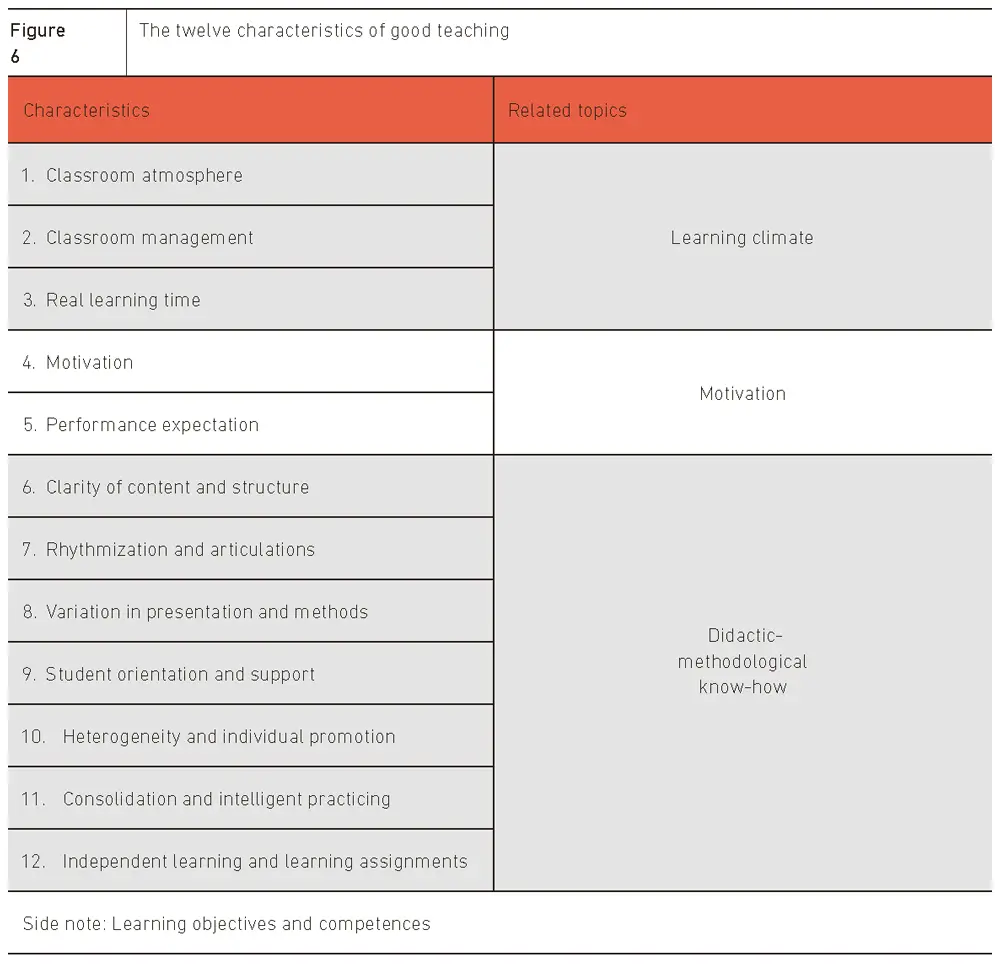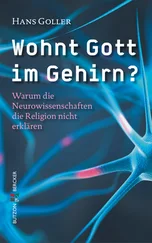The individual characteristics are primarily taken from the publications Visible learning for teachers by John Hattie3, Unterrichtsqualität und Lehrerprofessionalität (The quality of teaching and teacher professionalism) by Andreas Helmke4 and Was ist guter Unterricht? (What constitutes good teaching?) by Hilbert Meyer5. Each characteristic is thereby referenced with only a few key words which cannot be fully explained in this first chapter and which do not do justice to the nuanced sophistication with which they are presented in the original publications. In spite of the simplified short explanations, the aggregate list of the twelve characteristics provides a good orientation for classroom practice and design. The resultant inferred suggestions nevertheless yield useful instructions and means of action for practical application. A more intensive study from our perspective is meaningful, especially the very broad and particularly relevant themes of successful teaching. Hence the attached bibliographic references with certain characteristics. In our experience, a serious and sustained discussion with teaching practitioners about the characteristics of good teaching has produced extremely positive effects on school management – and with it, occupational satisfaction and the love for the teaching profession as well.
For better orientation, the twelve referenced characteristics of good teaching are listed in the table below and allocated to the superordinate topic areas. Furthermore, the table contains referenced to the comments on learning goals and competences .

Since we strive for the greatest possible transparency in terms of the origin of thoughts, ideas, and findings, we attribute the important contributions of individual authors and findings from Hattie’s meta-analyses in each of the twelve characteristics. However, we reference the authors only when, in our estimation, they can make a specific contribution to a characteristic which justifies their special highlighting.
1 Teaching climate
Helmke and Meyer talk about a climate conducive to learning . By this, they mean that a classroom climate of mutual respect is important, that rules are reliably followed, that all parties assume responsibility, and that a sense of justice and a willingness to help others are shared. The conversational tone must be friendly, the atmosphere characterized by cordiality and warmth, with room for laughter and humor. Moreover, there should be as many learning situations as possible that are not connected to performance assessment, and only as many achievement-oriented situations as necessary (see chapter 8). Concerning the pace of work, a relaxed atmosphere should be created: tolerance for slowness and a reasonable waiting time for student responses are considered important. Hattie equates the characteristics of a learning-conducive climate in the classroom with a high-effect strength in the areas of teacher-student relations, class cohesiveness, and low levels of fear. Hattie particularly emphasizes that an optimal classroom climate is characterized by an atmosphere of trust which tolerates mistakes as part of the learning process.
2 Classroom management
Conducting a class – or more specifically, classroom management – is often considered the most deciding factor of a successful teaching environment, not only by teachers, but also school management and educational authorities. Helmke considers it a necessary precondition for successful and ambitious teaching. Modern classroom management is based on the rules determined by teacher and students. It is imperative to address disruptions preventively with strategies of steering attention (that is, through instructions and organizational measures to control attention). When disruptions occur, they should be addressed discreetly and in a non-dramatic and time-saving fashion. Meyer does not include classroom management among the ten most important characteristics of good teaching, but his demands for clear structuring of teaching, a learning-conducive climate, and meaningful communication, comprise essential elements of classroom management. Efficient classroom management has a high impact on successful learning processes in Hattie’s meta-analysis. Because classroom management is generally considered important, but not always easy, the following example should shed some light on some possibilities for further in-depth study from among the great number of publications about the topic of classroom management: Disruptions in the classroom (Störungen in der Schulklasse) by Hans-Peter Nolting6 which further builds on the learning theory-based classic study by Jacob Kounin7 is a guideline to classroom management which goes far beyond Kounin’s classic study and aims at optimal behavior control and guidance and offers easily applicable and trainable suggestions for classroom management. Discipline and self-discipline in the school (Disziplin und Selbstdisziplin in der Schule) by Jürg Rüedi8 is rather deep psychology-oriented and emphasizes the relationship between teacher and students in classroom management. In our view, it is well worthwhile that not only prospective teachers but all teachers who would like to optimize their classroom management study this publication.
3 Real learning time
That total classroom time should entail the highest possible percentage of real learning is an essential characteristic of good teaching according to Meyer. This can be accomplished through good time management, punctuality, and most of all by deferring questions of an organizational nature outside of the defined, actual teaching time. The proportion of genuine learning time to total classroom time is important for Helmke as well, though he subsumes this point under efficient classroom management. In any case, it is certainly helpful to question how much time is lost in teaching with activities that cannot be attributed to learning.
4 Motivation
For Helmke, a diverse motivation is an important quality characteristic of teaching. Three different learning-relevant groups of motives should be considered. For one, it is important to consider the intrinsic learning motivation of students which manifests itself in their objective interests and activity interests. For another, the possibilities of extrinsic motivation can be utilized: the importance and usefulness of the learning material should be explained, the link to the living world of the students established, and the curiosity and achievement motivation should be encouraged. Ultimately, teacher engagement and the joy of the subject matter and teaching are transferred via the process of modelling to motivate students.
It is extraordinarily interesting that, according to Hattie’s research, the students’ self-assessment of their own performance level has by far the strongest influence on student success. There is evidently a relationship between the students’ motivation to deal with school-related content and Hattie’s outstanding findings. In light of the fact that Albert Bandura’s social cognitive learning theories and the complementary publications by Matthias Jerusalem (which focus more strongly on the German-speaking areas) resulted in similar conclusions, one has to agree that teaching should be conducted in a manner that strengthens self-assessment, self-efficacy – or most importantly – the self-confidence of the students. For a more in-depth study of these relationships, we refer to the classic study by Albert Bandura, Self-efficacy, 9 and the publication for pedagogy ( Zeitschrift für Pädagogik ) which devoted a special edition to just this topic, which, among other things, introduced a differentiated review of Matthias Jerusalem’s and Ralf Schwarzer’s concept of self-efficacy and discusses the concept with a permanent reference to the school.10
Читать дальше













